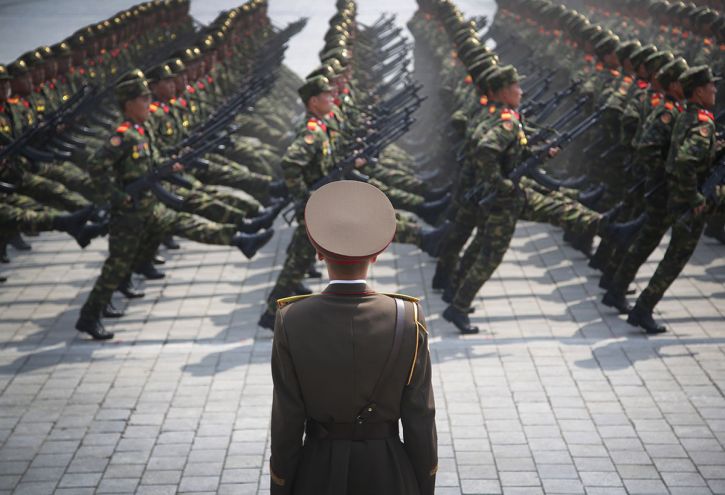Will North Korean Crisis Lead to Tribulation?
World news has recently been punctuated by tensions between North Korea and the U.S. Could a war between these nations lead to the Great Tribulation?
North Korean soldiers march to celebrate the 105th anniversary Kim Il Sung's birth on April 15, 2017.
As the war of words escalates, North Korea continues to threaten all-out nuclear war while the U.S. has begun installation of the Terminal High Altitude Area Defense (THAAD) antiballistic missile system in South Korea.
Sadly, this is not the only place where geopolitical tensions are rising. The Middle East and Russia continue to challenge global order and peace. As our world is seemingly deteriorating, students of Bible prophecy naturally wonder if we are witnessing the beginning of the end-time Great Tribulation.
Where are we in Bible prophecy?
What is the Great Tribulation?
The Olivet Prophecy is the first place where the phrase great tribulation is found in the Bible (Matthew 24:21). It is described as the worst time ever in all human history—unlike anything that will happen before or after it. It will be so destructive that if Jesus Christ doesn’t intervene, “no flesh would be saved” (verse 22). In other words, there would be complete human extinction.
As our world is seemingly deteriorating, students of Bible prophecy naturally wonder if we are witnessing the beginning of the end-time Great Tribulation.
This verse could not be fulfilled until modern times because mankind didn’t develop weapons that could end all human life until the 20th century. So could North Korea trigger the beginning of this time?
In this same prophecy, Jesus gave an overview of trends and events that will precede “the end of the age” (verse 3). A summary of those events are:
- Religious deception (verses 4-5).
- Wars and rumors of wars (verse 6).
- Famines (verse 7).
- Pestilences (verse 7).
These first four signs correspond to the four horsemen of the Apocalypse. Christ called them the “beginning of sorrows” (verse 8).
They are followed by:
- Persecution against God’s true Church (verses 9-13).
- The “abomination of desolation” (verse 15).
- God’s people fleeing to a place of safety (verses 16-20).
Verse 21 indicates the above three events are all connected with the “great tribulation.” Next, astronomical disturbances will occur “immediately after the tribulation” (verse 29).
This passage gives us a major clue about where the Great Tribulation will likely begin and where it will certainly escalate. We are told the “abomination of desolation” will be in the “holy place” and those in “Judea” are to flee. This means that the Great Tribulation will be in full force when these events in Jerusalem take place (Luke 21:20-21). Though Jerusalem is tense and continues to be a flashpoint in the ongoing Middle East conflict, none of these events has occurred there yet.
A closer look at the abomination of desolation
Since Christ gave this such high prominence in the Olivet Prophecy, let’s examine it more closely. Jesus was referring to the “abomination of desolation” that was originally written about by Daniel the prophet (Matthew 24:15). In Daniel 11:31 we read: “And forces shall be mustered by him, and they shall defile the sanctuary fortress; then they shall take away the daily sacrifices, and place there the abomination of desolation.”
This prophecy is part of a much larger prophecy of a long-running battle between the “king of the North” and the “king of the South.” Historically, the most prominent “king of the North” was Antiochus Epiphanes, who entered Jerusalem with his armies (Daniel 11:31). He stopped the priestly sacrifices at the temple and set up an altar to Zeus, using swine as an offering on it. He threatened death to any of the inhabitants who wouldn’t worship the pagan image.
This event was already history during His time, so Jesus was referring to a similar event that will occur in the end time. To learn more, read our article “Abomination of Desolation: What Is It?”
Jesus Christ will return roughly 3½ years after the Great Tribulation begins (Daniel 12:11; Revelation 11:2-3; 13:5).
For “the daily sacrifices” to be taken away, they first need to resume! Formal daily sacrifices have not been offered in Jerusalem since the Roman destruction of Herod’s temple in A.D. 70. So we must watch for this key sign, which must occur before the Great Tribulation begins.
Another key trend that must develop is the formation of the “king of the North” (also called “the beast”) in Europe and the “king of the South” (likely a confederation of Muslim nations) in the Middle East and northern Africa.
Beginning of sorrows
We read earlier that deceptions, wars and rumors of wars, famines, pestilences and earthquakes will mark the “beginning of sorrows” (Matthew 24:4-8). Jesus elaborated that during this time “nation shall rise against nation, and kingdom against kingdom” (verse 7). It seems that we are in, or approaching, that time.
Though we should watch the North Korean crisis closely, it will not lead to nuclear destruction of the planet or the Great Tribulation.
To stay abreast of news and trends related to prophecy, subscribe to our Insights Into News and Prophecy blog and Discern magazine.
Date Posted: April 24, 2017

 by Isaac Khalil
by Isaac Khalil

